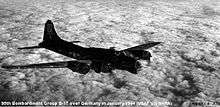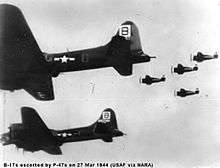RAF Horham
| Royal Air Force Station Horham USAAF Station 119 .png) | |
|---|---|
| Located Near Horham, Suffolk, United Kingdom | |
|
Aerial photograph of Horham airfield looking north, the bomb dump is to the rightof the airfield, barrack sites are on the left, 29 February 1944. Many of the 95th Bombardment Group B-17s are visible parked on hardstands around the perimeter track | |
 RAF Horham Map showing the location of RAF Horham within Suffolk. | |
| Coordinates | 52°18′40″N 001°13′34″E / 52.31111°N 1.22611°E |
| Type | Military airfield |
| Code | JH |
| Site information | |
| Controlled by | United States Army Air Forces |
| Site history | |
| Built | 1942 |
| In use | 1942-1946 |
| Battles/wars |
European Theatre of World War II Air Offensive, Europe July 1942 - May 1945 |
| Garrison information | |
| Garrison | Eighth Air Force |
| Occupants | 95th Bombardment Group |
RAF Horham is a World War II era airfield in England. The field is located next to the village of Horham, England, and 4 miles SE of Eye in Suffolk. The large site straddled the parishes of Denham, Horham, Redlingfield and Hoxne.[1]
United States Army Air Forces use

Planned originally for RAF use, Horham airfield was provided to the United States Army Air Forces Eighth Air Force in 1942. Two T-2 hangars were erected on the south side of the airfield and painted in black and dark earth shadow shading camouflage in contrast to later airfields where the hangars were finished in tar varnish. The technical site was adjacent to the two hangars beside the B1117 road to Eye. Station headquarters, administrative buildings and dispersed living sites were temporary constructions chiefly of to the west of the airfield in the parish of Denham. Horham was given USAAF designation Station 119 (JH).
USAAF Station Units assigned to RAF Horham were:[2]
- 457th Sub-Depot
- 18th Weather Squadron
- 8th Station Complement Squadron
- Headquarters (13th Combat Bomb Wing)
Regular Army Station Units included:
- 1210th Quartermaster Company
- 1285th Military Police Company
- 1676th Ordnance Supply & Maintenance Company
- 879th Chemical Company
- 2022nd Engineer Fire Fighting Platoon
From 13 September 1943 through 6 August 1945, Horham served as headquarters for the 13th Combat Bombardment Wing of the 3d Bomb Division.
47th Bombardment Group (Light)
The first USAAF unit to use Horham was the 47th Bombardment Group (Light), arriving from RAF Bury St. Edmunds on 5 October 1942. The 47th flew the Douglas A-20 Havoc light bomber. The group used Horham as a staging point for their departure to Mediouna, French Morocco joining Twelfth Air Force in January 1943.
323rd Bombardment Group (Medium)
The 323d Bombardment Group (Medium) arrived at Horham on 12 May 1943 from Myrtle Beach AAF South Carolina. The group was assigned to the 3d Bomb Wing and flew Martin B-26B/C Marauders with a Horizontal white tail band for its group marking. Operational squadrons of the 323d were:
- 453d Bombardment Squadron (VT)
- 454th Bombardment Squadron (RJ)
- 455th Bombardment Squadron (YU)
- 456th Bombardment Squadron (WT)
The group was assigned to the 8th Air Force at Horham however it transferred to RAF Earls Colne on 14 June before flying any operational missions from Horham.
95th Bombardment Group (Heavy)
With the transfer of the Marauders, the 95th Bombardment Group (Heavy) arrived from RAF Framlingham on 15 June 1943. the 95th was assigned to the 13th Combat Bombardment Wing, and the group tail code was a "Square-B". Its operational squadrons were:
- 334th Bombardment Squadron (BG)
- 335th Bombardment Squadron (OE)
- 336th Bombardment Squadron (ET)
- 412th Bombardment Squadron (QW)


The group flew the Boeing B-17 Flying Fortress as part of the Eighth Air Force's strategic bombing campaign and began bombing strategic objectives in Germany in July 1943 and engaged primarily in such operations until V-E Day. Targets included harbors, industries, marshalling yards, and cities.
The group received a Distinguished Unit Citation for maintaining a tight defensive formation in spite of severe assault by enemy fighters and bombing the aircraft assembly plant at Regensburg on 17 August 1943. Withstanding concentrated attacks by fighters during the approach to the target and intense antiaircraft fire directly over the objective, the group effectively bombarded marshalling yards at Münster on 10 October 1943, being awarded a 2d DUC for the performance.
The unit participated in the intensive campaign of heavy bombers against the German aircraft industry during Big Week, 20–25 February 1944. Received a 3d DUC for action during an attack by Army Air Force bombers on Berlin on 4 March 1944. While many participating organizations, because of weather conditions, either abandoned the operation or struck other targets, the 95th proceeded to Berlin and successfully bombed a suburb of the German capital despite snowstorms, dense clouds, and severe enemy attack.
The 95th interrupted its strategic operations to strike coastal defenses and communications during the invasion of Normandy in June 1944. The group hit enemy troop concentrations and thus assisted the Allied breakthrough at Saint-Lô in July 1944. The unit dropped ammunition, food, and medical supplies to Polish troops in Warsaw on 18 September 1944, and attacked enemy transportation during the Battle of the Bulge, December 1944 - January 1945 and bombed airfields in support of the Allied assault across the Rhine in March 1945.
The unit flew its last combat mission, an attack on marshalling yards at Oranienburg, on 20 April 1945. On 7 May 1945, the 95th flew a 'Chowhound' mission over the German occupied Netherlands. These missions, to drop supplies and food to Dutch civilians in German occupied territory, were carried out by the RAF and USAAF, the German authorities having given safe passage to these humanitarian flights. On the return leg B-17G 44-48640 overflew the Dutch port of IJmuiden, then a German E-boat base, and was fired on by an SS machine gun unit, which scored hits on the aircraft including No 2 engine which caught fire. The aircraft went down in the sea about 3 1⁄2 miles off Southwold, Suffolk. Of the 8 crew and 5 passengers on board there were four survivors.
This was the last B-17 shot down in the European Theatre of Operations. After V-E Day, transported liberated prisoners and displaced persons from Austria to France and England.
The 95th Bomb Group returned to Sioux Falls AAF South Dakota during June–August 1945, where the personnel were demobilized and aircraft sent to storage.
Legacy
The United States Air Force 95th Bombardment Wing (1952–1966) was a front-line Strategic Air Command heavy bomb wing during the Cold War. Assigned to Biggs AFB Texas, the wing was equipped initially with the Consolidated B-36 "Peacemaker", the first operational bomber to truly have intercontinental range, then re-equipped with the Boeing B-52 "Stratofortress". Upon activation, the Wing was bestowed the lineage, legacy and honors of the USAAF World War II 95th Bomb Group. It was inactivated on 12 June 1966.
Redesignated as the 95th Strategic Wing (1966–1976) and reassigned to Goose Air Base Canada 2 October 1966 the wing supported SAC's KC-135 alert tanker forces in eastern Canada and North Atlantic. It was inactivated 30 September 1976.
RAF Maintenance Command use
After the war, Horham was returned to the RAF on 9 October 1945 and it became a satellite for Nos. 25 and 262 Maintenance Units. The hangars were dismantled and it was declared a surplus inactive station in October 1946. Later, an RAF Bristol Bloodhound missile site used one part of the airfield but when this was moved, the complete site was sold during the years 1961-64.
Civil use

With the end of military control, a mushroom growing plant was established at the end of one runway during the 1960s, however much of the runways, perimeter track and hardstands were removed and ground into aggregate for construction projects in the area. The mushroom farm buildings have since been extended, and are used as a factory making glass-fibre mouldings until 2009. A small runway section is still used for light aircraft.
There is a memorial of the 95th Bomb Group and an active museum (the Red Feather Club) on the site of the former NCO's Mess. The former airfield hospital is similarly maintained as a museum and has periodic open days. The Guard Room now serves as Denham Village Hall. Elsewhere there are scattered remains of the outlying airfield buildings and bunkers in various degrees of condition.
See also
References
![]() This article incorporates public domain material from the Air Force Historical Research Agency website http://www.afhra.af.mil/.
This article incorporates public domain material from the Air Force Historical Research Agency website http://www.afhra.af.mil/.
Citations
- ↑ Bomb Group Heritage Association. "Horham Airfield, Station 119". The Base & Airfield. Retrieved 27 March 2014.
- ↑ "Horham". American Air Museum in Britain. Retrieved 16 Mar 2015.
Bibliography
- Conley, Harry M., No Foxholes in the Sky, 2002, FNP Military Division, Trumbull. CT. A first-person memoir of 89 combat missions as captain of a B-17 out of the Eighth AAF base at Horham, UK, by a Bomb Group Squadron CO and Chief of Staff, 93rd Combat Wing.
- Hawkins, Ian L., Courage * Honor * Victory A First Person History Of The 95th Bomb Group (H), 95th Bomb Group (H) Association, Bellevue, WN 1987
- Freeman, Roger A. (1978) Airfields of the Eighth: Then and Now. After the Battle ISBN 0-900913-09-6
- Freeman, Roger A. (1991) The Mighty Eighth: The Colour Record. Cassell & Co. ISBN 0-304-35708-1
- Maurer, Maurer (1983). Air Force Combat Units Of World War II. Maxwell AFB, Alabama: Office of Air Force History. ISBN 0-89201-092-4.
- Ravenstein, Charles A. (1984). Air Force Combat Wings Lineage and Honors Histories 1947-1977. Maxwell AFB, Alabama: Office of Air Force History. ISBN 0-912799-12-9.
- www.controltowers.co.uk Horham
- Horham at http://mighty8thaf.preller.us
- USAAS-USAAC-USAAF-USAF Aircraft Serial Numbers--1908 to present
External links
| Wikimedia Commons has media related to RAF Horham. |

